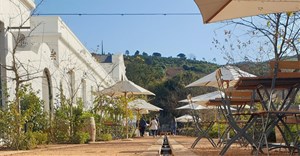
Green status for Nederburg

The farms are Nederburg, Groenhof, Plaisir de Merle and Papkuilsfontein. The latter two already have BWI status for setting aside 500 hectares and 150 hectares respectively for conservation. The supplier farm is also based in Darling and has been BWI-accredited for returning tracts of the farm to indigenous habitat.
Conservation methods
According to Hannes van Rensburg, group manager of Nederburg Wine Farms, all other suppliers to the winery are IPW (Integrated Production of Wine) accredited. He said the Nederburg farm, on which the winery was based and which covered 244 hectares, had very little uncultivated land to return to indigenous vegetation and had therefore focused its efforts on planting spekboom (Portulacaria afra) hedges for its ability to absorb and store carbon in the soil. The plan was also to sow wilde ertjie (Vicia benghalensis) between the spekbome as fodder for the Hereford and Angus cattle on the farm that provided the natural fertiliser for the vineyards. In addition, nitrogen-binding naturalised legumes, planted amongst the intra-vineyard cover crops, were helping to counter nitrogen emissions that contributed to smog and global warming.
The farm also used filtered effluent water from the cellars to irrigate the pastures, as was the case at Plaisir de Merle. In addition, its grape seeds were used to make grape seed oil.
The main thrust on Groenhof had been the clearing of alien vegetation which had not only seen tracts of renosterveld reappear but was also helping to restore the water balance. "With 98% of South Africa's water resources already fully allocated, there is an urgent need to reduce water usage and to invest in fresh water systems. We know from BWI research that 90% of natural disasters occurring during the 1990s may well have been water-related and that through holistic management of natural systems on wine farms, we can begin to mitigate the impact of climate change. The BWI has demonstrated that by maintaining healthy wetlands and riparian buffers, it is possible to combat erosion, limit flood damage, promote good quality water and even reduce vulnerability to flood and fire damage," says van Rensburg.
He added that with the removal of some 18 ha of pines on Plaisir de Merle, water was being saved and indigenous wild olive trees had been established. The farm, stretching from the Simonsberg escarpment virtually to the Berg River down in the valley, supports a rich biodiversity of animal and plant life, while the two rivers on the property harbour indigenous fish species and act as natural corridors for animals from the mountains to the lower-lying land. The fynbos high up on the Simonsberg abounds in Protea species.
Indigenous trees and thicket cover the ravines, providing a habitat for the extensive wildlife that ranges from various buck and porcupines to leopards and lynxes. Waterfowl are plentiful as are guinea fowl and pheasants with fish eagles and other birds of prey frequently visiting.
Papkuilsfontein has a large area of Swartland granite renosterveld, a critically endangered vegetation type, which is part of Contreberg on the Darling Hills. Fauna found on the farm include grysbok, duiker, caracal, jackal, as well as a wide variety of bird species.
Nederburg's cellar has also been SGS-accredited to produce organic wines. Some of the vineyards on Papkuilsfontein are farmed organically and are certified as such by SGS.

















